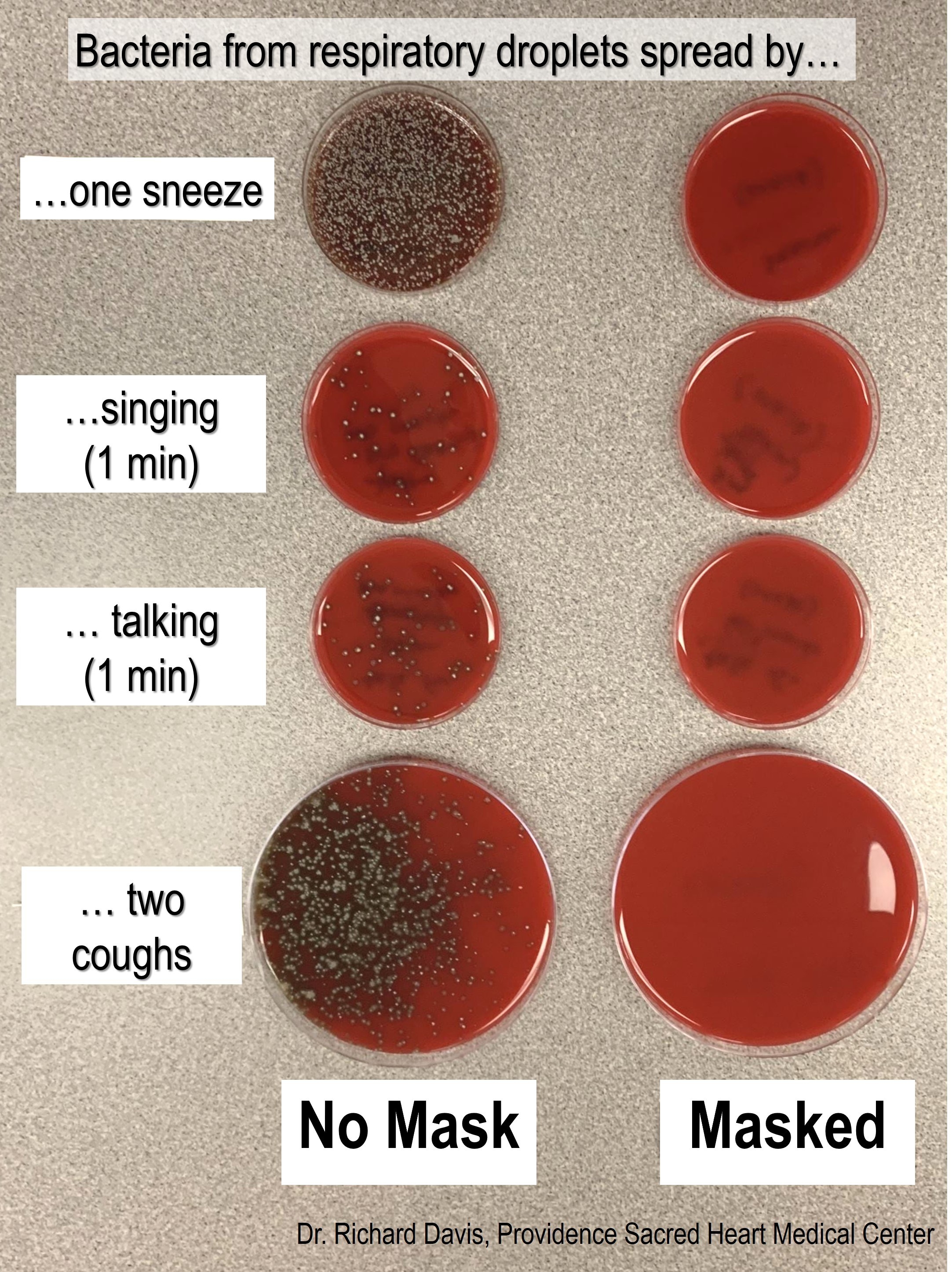Recently, there's been a lot of misinformation (and a lot of whining) about wearing masks during the pandemic.
We’re officially living in a Parks and Rec episode. #WearAMask
This cleverly edited video shows real people at real town hall meetings intercut with clips from Parks and Recreation. The effect is almost TOO good.
In response, scientists and medical professionals have been trying their damnedest to stop the spread of disinformation on platforms like Facebook and Twitter.
Masks do not drop your oxygen levels
Microbiologist Rich Davis is one of those. In a viral (no pun intended) tweet, he showed the results of a demonstration he put together showing just how big of a difference masks can make in halting the spread of respiratory droplets.
What does a mask do? Blocks respiratory droplets coming from your mouth and throat. Two simple demos: First, I sneezed, sang, talked & coughed toward an agar culture plate with or without a mask. Bacteria colonies show where droplets landed. A mask blocks virtually all of them.
For this demonstration, Dr. Davis held agar cultures near his face and sneezed, sang, talked, and coughed at them. For one set, he wore a standard surgical mask, and for the other he wore no mask.

He then left the cultures to grow the bacteria deposited by his respiratory droplets. So wherever you see a bacteria colony, that's an indication of where the droplets and bacteria from his mouth landed. It's crystal clear that the mask made a HUGE difference in the number of droplets that landed on the plates.

Dr. Davis also demonstrated the effectiveness of distance on the spread of droplets, standing at two feet, four feet, and six feet away from the culture plates and coughing hard for 15 seconds with and without a mask. While a six-foot difference greatly reduced the presence of bacteria, the mask still appeared more effective in all cases.
What about keeping your distance? Second demo: I set open bacteria culture plates 2, 4 and 6 feet away and coughed (hard) for ~15s. I repeated this without a mask. As seen by number of bacteria colonies, droplets mostly landed <6 ft, but a mask blocked nearly all of them.
Dr. Davis told BuzzFeed that this demonstration isn't likely to show the difference between mask types, and in the thread he notes how this is definitely a demonstration, not an experiment. After all, it's a sample size of one, and COVID-19 is a virus, not a bacteria.
I'm aware that this simple (n=1) demo isn't how you culture viruses or model spread of SARS-CoV-2. But colonies of normal bacteria from my mouth/throat show the spread of large respiratory droplets, like the kind we think mostly spread #COVID19, and how a mask can block them!
However, he expects that this demonstration would be "essentially the same" with other mask types (including N95, homemade, cotton, etc.), because essentially this shows that droplets leave our mouths when we cough, talk, sneeze, and sing, and that a mask can block most of them.
I try to be really clear what this does & does not show. DOES SHOW: the act of talking (or coughing, sneezing, singing) causes particles of liquid to come out of your mouth. DOES SHOW: those droplets can carry microbes like bacteria DOES SHOW: a mask blocks most of those
Dr. Davis also addressed in the thread that there are certain data points that we can infer from the demonstration, although it doesn't explicitly show them.
DOES NOT SHOW: what is the number, size, and distribution of respiratory droplets produced by coughing/talking etc. DOES NOT SHOW: could these droplets carry viruses (like SARS-CoV-2), does a mask block THOSE (Based on what we know you can intuit/infer this, but it's not shown)
For example, the CDC has stated that COVID-19 spreads "mainly" through respiratory droplets like these, so we can infer that a mask would very likely block those droplets as well and with them, most of the viral load...even if this demonstration doesn't show that directly.
100% true: bacteria are incredibly different from viruses! But since we expect respiratory droplets to be what primarily spreads #COVID19, I exploit the presence of (easily to grow and visualize) bacteria in respiratory droplets, to show where they go. https://t.co/V7zXe2lxbV
So while this isn't a robust experiment about the different types of masks and how effective they are against COVID-19 specifically, we can get a lot of visual data about just how well masks can reduce transmission of droplets in general. Even a homemade cloth mask is going to be better than nothing!
So COULD you test different masks with this same set up? Yes. Would it be different? Eh. Probably not. A mask preventing your spit & breath from flying out of your mouth, even if doesn't catch it all, will stop some spread of bacteria (see here) AND LIKELY VIRUS (not seen here)
Of course, people also had some other questions for Dr. Davis, including wondering what he sang during the demonstration. Answer: some Hamilton!
OK here's what was probably the most common question I saw: what did I sing at (to??) my culture plates. It was "Dear Theodosia" from Hamilton, top of my lungs. If I could have anyone's singing talent it would be Leslie Odom Jr.'s. (Spoiler: I don't.) https://t.co/tEf2gKockr
In short, Dr. Davis recommends that face masks and face shields should be a normalized part of hygiene, just like washing our hands or sneezing into tissues. So put 'em on, folks!
Masks as a political/social litmus test or used to shame those who won't (or disabled folks who truly can't!) wear them is a travesty. We wash hands after using the bathroom & wipe noses on tissues. Masks/face shields need to be just another normalized act of hygiene. #MasksWork
